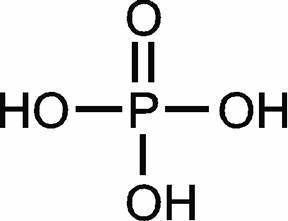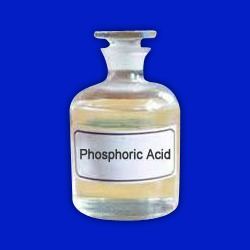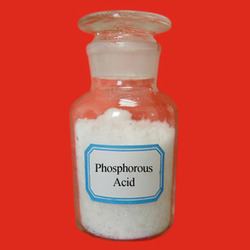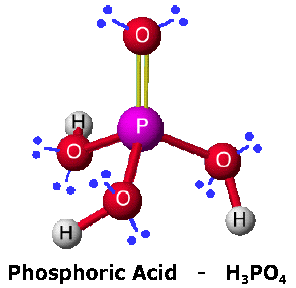Formula H3PO4 IUPAC ID Phosphoric acid Boiling point 158 °C Soluble in Water | Molar mass 98 g/mol Density 1.88 g/cm³ Melting point 42.35 °C | |
 | ||
Appearance white solid or colourless, viscous liquid (>42 °C)
deliquescent | ||
Phosphoric acid (also known as orthophosphoric acid or phosphoric(V) acid) is a mineral (inorganic) acid having the chemical formula H3PO4. Orthophosphoric acid refers to phosphoric acid, which is the IUPAC name for this compound. The prefix ortho is used to distinguish the acid from related phosphoric acids, called polyphosphoric acids. Orthophosphoric acid is a non-toxic acid, which, when pure, is a solid at room temperature and pressure. The conjugate base of phosphoric acid is the dihydrogen phosphate ion, H
2PO−
4, which in turn has a conjugate base of hydrogen phosphate, HPO2−
4, which has a conjugate base of phosphate, PO3−
4. Phosphates are nutritious for all forms of life.
Contents
- Chemistry chemical bonding 25 of 35 lewis structures phosphoric acid h3po4
- Reactions
- Aqueous solution
- Preparation
- Wet
- Thermal
- Laboratory routes
- Uses
- Food additive
- Rust removal
- In medicine
- Other applications
- Exposure
- Toxicology
- Incompatibilities
- In the Household
- Other Considerations
- Handling
- Storage
- References

In addition to being a chemical reagent, phosphoric acid has a wide variety of uses, including as a rust inhibitor, food additive, dental and orthop(a)edic etchant, electrolyte, flux, dispersing agent, industrial etchant, fertilizer feedstock, and component of home cleaning products. Phosphoric acids and phosphates are also important in biology.

The most common source of phosphoric acid is an 85% aqueous solution; such solutions are colourless, odourless, and non-volatile. The 85% solution is a syrupy liquid, but still pourable. Although phosphoric acid does not meet the strict definition of a strong acid, the 85% solution is acidic enough to be corrosive. Because of the high percentage of phosphoric acid in this reagent, at least some of the orthophosphoric acid is condensed into polyphosphoric acids. For the sake of labeling and simplicity, the 85% represents H3PO4 as if it were all orthophosphoric acid. Dilute aqueous solutions of phosphoric acid exist in the ortho- form.

Chemistry chemical bonding 25 of 35 lewis structures phosphoric acid h3po4
Reactions

Orthophosphoric acid molecules can combine with themselves to form a variety of compounds which are also referred to as phosphoric acids, but in a more general way.

Anhydrous phosphoric acid, a white low melting solid, is obtained by dehydration of 85% phosphoric acid by heating under a vacuum.
Orthophosphoric acid ionizes upon dissolving in water, mainly to give H2PO−
4 and protons:
4(aq) Ka1= 7.5×10−3 H2PO−
4(aq) + H2O(l) ⇌ H3O+(aq) + HPO2−
4(aq) Ka2= 6.2×10−8 HPO2−
4(aq) + H2O(l) ⇌ H3O+(aq) + PO3−
4(aq) Ka3= 2.2×10−13

The anion after the first dissociation, H2PO−
4, is the dihydrogen phosphate anion. The anion after the second dissociation, HPO2−
4, is the hydrogen phosphate anion. The anion after the third dissociation, PO3−
4, is the phosphate or orthophosphate anion. For each of the dissociation reactions shown above, there is a separate acid dissociation constant, called Ka1, Ka2, and Ka3 given at 25 °C. Associated with these three dissociation constants are corresponding pKa1=2.12, pKa2=7.21, and pKa3=12.67 values at 25 °C. Even though all three hydrogen (H) atoms are equivalent on an orthophosphoric acid molecule, the successive Ka values differ since it is energetically less favorable to lose another H+ if one (or more) has already been lost and the molecule/ion is more negatively charged.
Because the triprotic dissociation of orthophosphoric acid, the fact that its conjugate bases (the phosphates mentioned above) cover a wide pH range, and, because phosphoric acid/phosphate solutions are, in general, non-toxic, mixtures of these types of phosphates are often used as buffering agents or to make buffer solutions, where the desired pH depends on the proportions of the phosphates in the mixtures. Similarly, the non-toxic, anion salts of triprotic organic citric acid are also often used to make buffers. Phosphates are found pervasively in biology, especially in the compounds derived from phosphorylated sugars, such as DNA, RNA, and adenosine triphosphate (ATP). There is a separate article on phosphate as an anion or its salts.
Upon heating orthophosphoric acid, condensation of the phosphoric units can be induced by driving off the water formed from condensation. When one molecule of water has been removed for each two molecules of phosphoric acid, the result is pyrophosphoric acid (H4P2O7). When an average of one molecule of water per phosphoric unit has been driven off, the resulting substance is a glassy solid having an empirical formula of HPO3 and is called metaphosphoric acid. Metaphosphoric acid is a singly anhydrous version of orthophosphoic acid and is sometimes used as a water- or moisture-absorbing reagent. Further dehydrating is very difficult, and can be accomplished only by means of an extremely strong desiccant (and not by heating alone). It produces phosphoric anhydride (phosphorus pentoxide), which has an empirical formula P2O5, although an actual molecule has a chemical formula of P4O10. Phosphoric anhydride is a solid, which is very strongly moisture-absorbing and is used as a desiccant.
In the presence of superacids (acids stronger than H
2SO
4), H
3PO
4 reacts to form poorly characterized products, perhaps corrosive, acidic salts of the hypothetical tetrahydroxylphosphonium ion, which is isoelectronic with orthosilicic acid. The suspected reaction with HSbF
6, for example, is supposed to go:
4] [SbF6]−
Aqueous solution
For a given total acid concentration [A] = [H3PO4] + [H2PO−
4] + [HPO2−
4] + [PO3−
4] ([A] is the total number of moles of pure H3PO4 which have been used to prepare 1 liter of solution), the composition of an aqueous solution of phosphoric acid can be calculated using the equilibrium equations associated with the three reactions described above together with the [H+] [OH−] = 10−14 relation and the electrical neutrality equation. Possible concentrations of polyphosphoric molecules and ions is neglected. The system may be reduced to a fifth degree equation for [H+] which can be solved numerically, yielding:
For strong acid concentrations, the solution is mainly composed of H3PO4. For [A] = 10−2, the pH is close to pKa1, giving an equimolar mixture of H3PO4 and H2PO−
4. For [A] below 10−3, the solution is mainly composed of H2PO−
4 with [HPO2−
4] becoming non-negligible for very dilute solutions. [PO3−
4] is always negligible. Since this analysis does not take into account ion activity coefficients, the pH and molarity of a real phosphoric acid solution may deviate substantially from the above values.
Preparation
Phosphoric acid is produced industrially by two general routes – the thermal process and the wet process, which includes two sub-methods. The wet process dominates in the commercial sector. The more expensive thermal process produces a purer product that is used for applications in the food industry.
Wet
Wet process phosphoric acid is prepared by adding sulfuric acid to tricalcium phosphate rock, typically found in nature as apatite. The reaction is:
Ca5(PO4)3X + 5 H2SO4 + 10 H2O → 3 H3PO4 + 5 CaSO4·2 H2O + HX where X may include OH, F, Cl, and BrThe initial phosphoric acid solution may contain 23–33% P2O5 (32–46% H3PO4), but can be concentrated by the evaporation of water to produce commercial- or merchant-grade phosphoric acid, which contains about 54–62% P2O5 (75–85% H3PO4). Further evaporation of water yields superphosphoric acid with a P2O5 concentration above 70% (corresponding to nearly 100% H3PO4; however, pyrophosphoric and polyphosphoric acids will start to form, making the liquid highly viscous).
Digestion of the phosphate ore using sulfuric acid yields the insoluble calcium sulfate (gypsum), which is filtered and removed as phosphogypsum. Wet-process acid can be further purified by removing fluorine to produce animal-grade phosphoric acid, or by solvent extraction and arsenic removal to produce food-grade phosphoric acid.
The nitrophosphate process is similar to the wet process except that it uses nitric acid in place of sulfuric acid. The advantage to this route is that the coproduct, calcium nitrate is also a plant fertilizer. This method is rarely employed.
Thermal
Very pure phosphoric acid is obtained by burning elemental phosphorus to produce phosphorus pentoxide, which is subsequently dissolved in dilute phosphoric acid. This route produces a very pure phosphoric acid, since most impurities present in the rock have been removed when extracting phosphorus from the rock in a furnace. The end result is food-grade, thermal phosphoric acid; however, for critical applications, additional processing to remove arsenic compounds may be needed.
Elemental phosphorus is produced by an electric furnace. At a high temperature, a mixture of phosphate ore, silica and carbonaceous material (coke, coal etc...) produces calcium silicate, phosphorus gas and carbon monoxide. The P and CO off-gases from this reaction are cooled under water to isolate solid phosphorus. Alternatively, the P and CO off-gases can be burned with air to produce phosphorus pentoxide and carbon dioxide.
Laboratory routes
A demonstrative process consists in the oxidation of red phosphorus by nitric acid.
1/n Pn + 5 HNO3 → H2O + H3PO4 + 5 NO2Uses
The dominant use of phosphoric acid is for fertilizers, consuming approximately 90% of production.
Food additive
Food-grade phosphoric acid (additive E338) is used to acidify foods and beverages such as various colas and jams. It provides a tangy or sour taste. Various salts of phosphoric acid, such as monocalcium phosphate, are used as leavening agents.
Rust removal
Phosphoric acid may be used to remove rust by direct application to rusted iron, steel tools, or other surfaces. The phosphoric acid changes the reddish-brown iron(III) oxide, Fe2O3 (rust) to ferric phosphate, FePO4. An empirical formula for this reaction is:
2 H3PO4 + Fe2O3 → 2 FePO4 + 3 H2OLiquid phosphoric acid may be used for dipping, but phosphoric acid for rust removal is more often formulated as a gel. As a thick gel, it may be applied to sloping, vertical, or even overhead surfaces. Different phosphoric acid gel formulations are sold as "rust removers" or "rust killers". Multiple applications of phosphoric acid may be required to remove all rust. Rust may also be removed via phosphate conversion coating. This process can leave a black phosphate coating that provides moderate corrosion resistance (such protection is also provided by the superficially similar Parkerizing and blued electrochemical conversion coating processes).
In medicine
Phosphoric acid is used in dentistry and orthodontics as an etching solution, to clean and roughen the surfaces of teeth where dental appliances or fillings will be placed. Phosphoric acid is also an ingredient in over-the-counter anti-nausea medications that also contain high levels of sugar (glucose and fructose). This acid is also used in many teeth whiteners to eliminate plaque that may be on the teeth before application.
Other applications
Among many applications, phosphoric acid is used:
Exposure
The exact dangers of phosphoric acid, H3PO4, depend on the concentration strength of the solution, with higher concentrations presenting greater hazards. Phosphoric acid, 85 wt.% is considered a corrosive chemical solution that can cause severe skin burns and permanent eye damage. Inhalation and ingestion can also have serious effects. See exposure symptoms below:
Toxicology
Phosphoric acid is not a known carcinogen, mutagen, nor is it known to exhibit toxicity towards a growing embryo or the reproductive systems.
Incompatibilities
Strong bases (e.g. sodium hydroxide), strong oxidizers (e.g. perchloric acid), and certain metals (e.g. aluminum). Violent reactions and splattering of dangerous chemicals can occur upon mixing H3PO4 with a strong base. There is an increased risk of fire or causing an explosion from adding strong oxidizers to phosphoric acid. Phosphoric acid will attack many metals and drive the formation of highly flammable and potentially explosive hydrogen gas. If flammable combustion occurs, toxic fumes of phosphorous oxides will form.
In the Household
Examples of household products that contain or can contain H3PO4 are: cleaners for toilet bowls, grout, tile, automobile rims, some general purpose cleaners/degreasers; some hair/beauty products; and some toothpastes and mouth rinses may contain phosphoric acid. These examples, while the amount of H3PO4 may be dilute, still present potential health hazards and should always be handled safely. Additionally, never mix chemicals at home unless fully aware of the occurring chemical reaction, hazards, and safe-handling precautions necessary to remain safe. In example, the mixing of household bleach and phosphoric acid from a toilet bowl cleaner can cause the release of highly toxic chlorine gas.
Other Considerations
Phosphoric acid is not combustible, nor flammable, and will not burn in itself. Flammability of the chemical exists only from incompatible reactions with other compounds/materials. Decomposition of H3PO4 to toxic fumes readily occurs upon mixing with: alcohols, aldehydes, cyanides, ketones, phenols, esters, sulfides, and halogenated organics.
Handling
Personal protective equipment recommended for handling of H3PO4, 85 wt.%:
To prevent exposure, the CDC recommends taking serious precautions to prevent the generation of mists, avoiding potentially hazardous exposure to eyes, skin, and nasal passageways. The CDC also recommends no eating, drinking, or smoking when handling phosphoric acid to avoid the possibility of ingestion.
Storage
Store H3PO4 in containers made of corrosion-resistant materials. Sigma-Aldrich recommends storing phosphoric acid in a stainless steel container with a resistant inner lining. Containers should always be stored upright to avoid leaks. Do not store in incompatible metals such as aluminum, the alloys of aluminum, and carbon steel. Store away from all incompatible chemicals and compounds. Keep away from food and feedstuffs. Ensure any solid material is kept dry. Do not reuse containers, even if they appear clean and empty.
